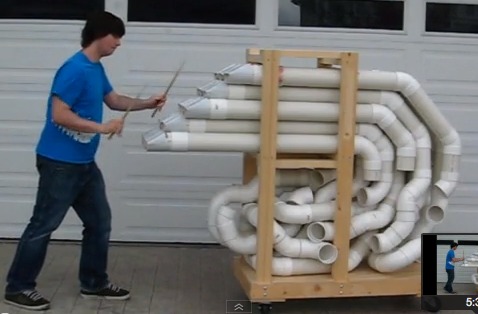Build an organ
Build a simple tabletop pipe organ from cardboard tubes, straws, and a balloon blower, then test how pipe length and air affect pitch.



Step-by-step guide to build a tabletop pipe organ
A music lesson | Instruments and musical figures for kids
Step 1
Gather all the materials and clear a flat workspace so you have room to build.
Step 2
Cut the cardboard base to a size that fits at least five tubes side by side using scissors.
Step 3
Use the ruler and marker to measure and mark five different tube lengths on your cardboard tubes for low to high notes (for example 30 cm 25 cm 20 cm 15 cm 10 cm).
Step 4
Cut the tubes at your marked lines so you have five different-length pipes.
Step 5
Press a blob of modeling clay into one end of each tube to seal the bottom of every pipe.
Step 6
Cut each drinking straw so it is about 2 centimeters shorter than the tube it will go into.
Step 7
Push one cut straw into the open top of each tube so about 2 centimeters of straw stick out to make a mouthpiece.
Step 8
Tape each tube upright onto the cardboard base spaced evenly so the mouthpieces face the player.
Step 9
Press more clay or tape around each straw where it meets the tube to make an airtight seal.
Step 10
Use the balloon pump to blow a steady stream of air into one straw mouthpiece and listen to the sound that pipe makes.
Step 11
Repeat blowing softly and then harder into each straw to test how air strength changes the pitch for every pipe.
Step 12
Write down which tube lengths make low medium and high notes and how stronger or softer air changed the pitch.
Step 13
Take a photo or short description and share your finished tabletop pipe organ and findings on DIY.org
Final steps
You're almost there! Complete all the steps, bring your creation to life, post it, and conquer the challenge!


Help!?
Can I substitute any hard-to-find materials like cardboard tubes, modeling clay, or the balloon pump?
Yes — use paper-towel or wrapping-paper tubes for the pipes, play-dough or hot-melt glue to seal the bottoms instead of modeling clay, and a camera air blower or an adult's steady breath in the step 'Use the balloon pump' if you don't have a pump.
The pipes don't make sound or the pitch won't change—what should I check?
Make sure each straw is cut about 2 cm shorter than its tube and that you press clay or tape around the straw where it meets the tube (steps 'Cut each drinking straw…' and 'Press more clay…') and that every tube is taped upright and sealed to the cardboard base so air doesn't leak.
How can I adapt this organ activity for different age groups?
For preschoolers use three pre-cut tubes and let them press clay and blow with help, for elementary kids have them measure, mark, and cut the five tube lengths themselves, and for older kids add more tubes, precise ruler measurements, and a smartphone tuner when testing and recording results in the 'Write down which tube lengths…' step.
How can we enhance or personalize our tabletop pipe organ after building it?
Paint and label each tube for notes, glue a simple cardboard keybed to tap the mouthpieces, and fine-tune pitches by trimming tube lengths or changing the straw mouthpiece length after you 'Write down which tube lengths make low medium and high notes'.
Watch videos on how to build a tabletop pipe organ
How To Play Hammond Organ - Everything You Need To Know
Facts about sound and acoustics
🎯 A pipe's pitch comes from the vibrating column of air inside it, so changing length or open/closed ends changes the note.
🎈 A stretched balloon or a straw blower helps produce steady airflow, which makes cardboard and tube pipes speak more clearly.
🧪 Blowing harder usually makes a pipe louder and can slightly raise the pitch because of faster airflow and stronger vibrations.
🎵 Doubling the length of an open pipe lowers its fundamental pitch by one octave — longer pipes make deeper notes.
🏆 The largest pipe organ (Boardwalk Hall) has over 33,000 pipes — much more than a tabletop organ, but the same physics!
How do I build a simple tabletop pipe organ from cardboard tubes, straws, and a balloon blower?
What materials do I need to make a cardboard tube pipe organ?
What ages is this tabletop pipe organ activity suitable for?
What safety precautions should I follow when building and playing with a cardboard pipe organ?


One subscription, many ways to play and learn.
Only $6.99 after trial. No credit card required



